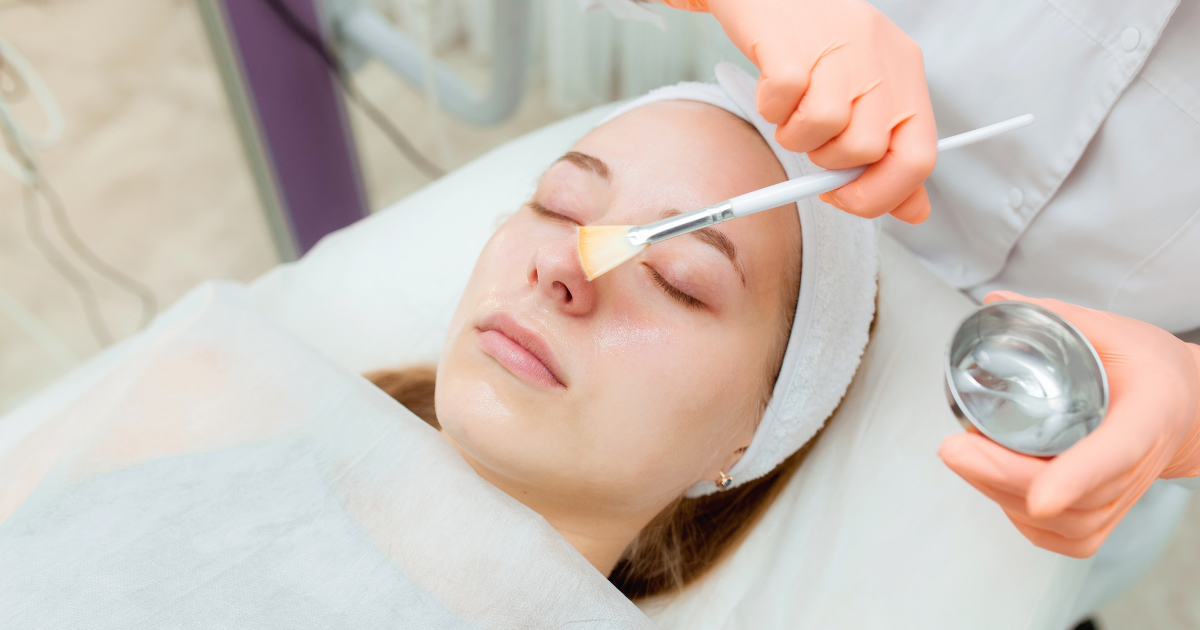Facial or Medical Procedure? How to Know When Your Beauty Treatment Should Be Left to a Doctor
Your guide to what’s safe in a spa—and what’s not


During one idle evening scroll through social media, my thumb stopped short. The video before me was titled “My story about how Sonya Dakar permanently damaged my face.”
I recognised the name. Sonya Dakar has reportedly been a powerhouse in the beauty industry for decades, providing bespoke facials to Los Angeles’s most luminous faces. She is said to have treated everyone from Jennifer Lopez to Gwyneth Paltrow to Priyanka Chopra. Scoring an appointment with her is considered the beauty world’s equivalent of a front-row seat at fashion week. So how, I wondered, could she have allegedly caused irreparable damage to this young woman’s face?
In her TikTok video, Victoria recounts her experience. “She was so intelligent and so convinced that we would be able to clear my acne.” By all accounts, Dakar did indeed clear Victoria’s acne, and Victoria became a devoted client—posting her results on Instagram and even bringing family members in for treatments.
“Flash forward to April 2021 and I was going in for a routine facial. She insists we finish out the appointment with a peel. I trusted her. She was the expert, she knew my skin better than anyone else, and the way it’s described on her website and in the room is having no down time or irritation.”
According to Victoria, Dakar applied the solution to her face using a dropper. “I felt this immediate burning. [My face] was on fire and I was confused why it hurt so badly. I opened the front-facing camera on my phone to use as a mirror… [I saw] my skin just burned.”
@victoria.nelson sorry, it’s a bit long but it’s long overdue. This is my story about how celebrity esthetician, Sonya Dakar burned, scarred and irreparably damaged my face. I’m perpetually consciously and subconsciously covering it up, but I’m not sure why I’m the one who feels ashamed and like I have to hide something in this situation. In an ideal world, this would’ve all been handled privately and professionally..but after doing everything in my power to take the “right” steps and handle things the “right” way through the proper channels, unfortunately, I have been left no other option but to publicly share about such an incredibly vulnerable experience. All I ask is that you please be kind, and please.. be safe 🤍
♬ original sound - Victoria Nelson
What allegedly followed were years of costly corrective treatments—reportedly tens of thousands of dollars’ worth—with limited improvement. To this day, Victoria has visible scarring across her cheeks and forehead.
The allegations have reignited conversations about the lack of regulation within the beauty and aesthetics industry. As consumers, we place an immense amount of trust in those we allow to touch our skin. But when even the industry’s biggest names are facing allegations like these, it raises an uncomfortable question: how can we truly keep ourselves safe?
Celebrity news, beauty, fashion advice, and fascinating features, delivered straight to your inbox!
I spoke to two of the UK’s top doctors—Consultant Dermatologist Dr Derrick Phillips and Dr Sophie Shotter, President of BCAM—to clarify what should (and should not) fall within an aesthetician’s remit.
What treatments are safely within an aesthetician’s scope of practice?
According to consultant dermatologist Dr Derrick Phillips, aestheticians “are trained beauty therapists who often work alongside doctors or nurses in aesthetic clinics.” They can, he says, “safely carry out treatments like facials, light to medium chemical peels, microneedling and some laser or light-based procedures, as long as they’ve had the right training and are working within their qualifications and insurance.” Anything that involves prescription products or injections, however, “should always be done by a medical professional.”
Dr Sophie Shotter, President of BCAM, agrees that non-invasive treatments sit comfortably within a beauty therapist’s remit. “In the UK, anyone providing beauty or aesthetic treatments must have relevant accredited training and insurance,” she explains. “Non-invasive skin treatments are generally considered within a beauty therapist or aesthetician’s scope—this usually includes facials, light superficial chemical peels, microdermabrasion, LED light therapy, dermaplaning and some basic body treatments.” With further qualifications, she adds, “some types of laser, radiofrequency and radiofrequency microneedling, ultrasound skin tightening, and slightly deeper peels (still not to the level of the dermis) may also be appropriate.”
Which treatments should only be performed by medical professionals?
Both experts draw a clear line when it comes to higher-risk procedures. Dr Phillips warns that “any treatment that involves prescription-only medicines or carries a higher medical risk should be performed by a qualified medical professional. This includes injectable treatments such as Botox and dermal fillers, deeper chemical peels, and ablative laser procedures that remove layers of skin.” These treatments, he adds, “require detailed knowledge of skin anatomy, aseptic technique and the ability to manage complications safely.”
For Dr Shotter, it’s similarly straightforward. “For me, medical treatments are those which carry more risk and which could need prescription treatments to address any complications,” she says. “These include any injectable treatments (Botox, dermal fillers, PRP, polynucleotides, skin boosters), more involved laser and IPL treatments (especially anything ablative), medium-to-deep chemical peels (e.g. TCA >30%, phenol peels), deeper radiofrequency microneedling treatments, and any sort of mole or lesion removal.”
The “grey area” treatments
Of course, not every procedure sits neatly on one side of the line. “There are definitely some treatments that fall into a grey area,” admits Dr Phillips. “Things like microneedling, peels and certain laser or light-based procedures can be very effective, but they need to be used with care. Without medical training, it’s easy to pick the wrong treatment for someone’s skin. For example, using IPL on darker skin tones or to treat melasma can actually make pigmentation worse.”
He recalls one patient with skin of colour who “came to see me after having a chemical peel that was far too aggressive for her skin. Instead of improving her skin tone, it left her with significant post-inflammatory hyperpigmentation that took months to settle.” These treatments, he stresses, “aren’t inherently unsafe, but they do rely on good judgement and an understanding of skin biology.”
Dr Shotter notes that these borderline treatments are often the ones most misunderstood. “Many of the treatments I’ve covered in the ‘with further training’ category are those grey areas,” she says. “Microneedling to deeper depths, chemical peels that go a little deeper, radiofrequency microneedling, ultrasound skin tightening and laser treatments all come with real caveats. My aesthetician does perform many of these treatments, but with the oversight of me and my medical team and the knowledge that we are there to support should any problems arise.”
When to see a doctor, not an aesthetician
Knowing when to seek medical care rather than a facial is critical. “If you’re dealing with an ongoing skin concern rather than just looking to refresh or maintain your skin, it’s usually best to see a dermatologist,” advises Dr Phillips. “Persistent acne, rosacea, eczema, pigmentation, unexplained rashes or scarring all warrant medical assessment rather than purely cosmetic treatment.”
Aestheticians, he says, “are brilliant for maintenance and for keeping the skin in good condition, but if something keeps recurring, is getting worse, or isn’t responding to over-the-counter products, that usually suggests that medical input is required.”
Dr Shotter echoes the sentiment. “See an aesthetician if you want surface improvement—glow, mild pigmentation—and your concerns are mild and not affecting your health,” she says. “See a medical professional if you have persistent skin conditions like acne, eczema or rosacea, you need a diagnosis of something, you’re considering more involved treatments like injectables or laser resurfacing, or you’re looking for more substantial improvements. Also seek out medical help if you have experienced problems from any previous treatments.”
A note on chemical peels
Chemical peels, a cornerstone of many skin clinics, are particularly prone to confusion. “‘The term “medical grade” isn’t actually regulated, so it can be quite misleading,’” warns Dr Phillips. “What really matters is the strength of the peel, the ingredients and who’s carrying it out. Lighter peels using mild acids like lactic or mandelic acid can be perfectly safe in a spa setting when performed by a trained aesthetician.
“Stronger peels containing higher concentrations of glycolic or trichloroacetic acid (TCA) penetrate deeper into the skin and should only be done in a medical clinic, ideally under the supervision of a doctor or nurse.” If a peel claims to deliver “dramatic” or “deep” results, he advises checking that you’re in a medically led setting.
Dr Shotter elaborates: “In the UK, chemical peels range from gentle, cosmetic-grade treatments to more potent medical-grade procedures, and the key differences lie in their strength, depth and who performs them. Peels offered in spas or salons are usually superficial, using lower concentrations of acids (such as glycolic or lactic acid under ~20%) to exfoliate the top layer of skin with little to no downtime.
“In contrast, medical-grade peels use stronger solutions (like TCA above 30% or phenol) that penetrate deeper into the skin, often causing visible peeling and requiring longer recovery. These higher-strength peels should only be performed by trained medical professionals—such as doctors or nurses—ideally in a setting that’s regulated by the Care Quality Commission.”
At its core, the viral video about Sonya Dakar has struck a nerve because it exposes how vulnerable we are in an under-regulated beauty landscape. Treatments once reserved for clinics are now available on high streets or behind closed doors, often with little oversight. As Dr Phillips reminds us, “In the right hands, they can achieve great results—but when used inappropriately, they can do more harm than good.”
Marie Claire UK contacted the Sonya Dakar Skin Clinic for comment but had not received a response by the time of publication.

Lottie Winter is the Beauty Director at Marie Claire UK. With over a decade of beauty journalism under her belt, she brings a desire to cut through the noise and get to what really matters–– products that deliver, conversations that empower, and beauty that makes people feel like their best selves.